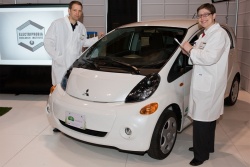 Mitsubishi’s “Electriphobia Institute.” Click image to enlarge |
Article and photos by Mike Schlee
Just in time for Earth Day, Mitsubishi has debuted a new web-based advertising campaign called the “Electriphobia Institute” at the Green Living Show in Toronto. The Electriphobia Institute campaign is designed to dispel the common fears and myths associated with electric vehicles. Dressed in lab coats, Mitsubishi personnel presented the new campaign, included some web-based video ads, during media day of the Green Living Show at the Direct Energy Centre in Toronto.
“The objective is to raise awareness about electric vehicles and share truths about the game-changing technology in our all-new i-MiEV pure electric vehicle. Through the ‘Institute’ we want to prepare EV consumers for the experience of never again visiting a gas station, having a tailpipe, or changing the oil,” said Peter Renz, director of marketing at Mitsubishi Canada.
Although a little skeptical of this idea initially, as it could very easily come off as forced and cheesy, I’m happy to say Mitsubishi has done a great job with this campaign and had us laughing in our seats during their presentation — not a small feat for an 8:30 am presentation to many groggy Toronto rush-hour commuters. Of particular note for me was the video weaning people off of their “tailpipe” addiction.
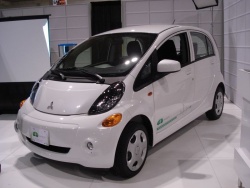 Mitsubishi i-Miev. Click image to enlarge |
All-new for 2012, Mitsubishi recently introduced the 2nd all-electric mass-produced vehicle sold in Canada. Based on the 10-year-old Mitsubishi i, MiEV stands for Mitsubishi innovative Electric Vehicle. Power comes from a 49-kW AC synchronous motor that produces 66 hp from 3,000–6,000 rpm and 145 lb-ft of torque from 0 rpm. The i-MiEV is a mid-engined vehicle that sends electric thrust, up to 9,900 rpm, through a single-speed, fixed reduction gear to the rear wheels. Electric juice for this drivetrain is stored in a 16-kWh, 330V, 88-cell lithium-ion battery. This leads to an official range of up to 155 kilometres in ideal conditions, which doesn’t include its top speed of 130 km/h. Since its introduction this winter, Mitsubishi has sold 69 i-MiEVs in Canada, which isn’t too bad considering Nissan sold only 170 Leafs in 2011.
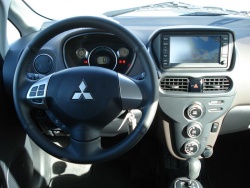 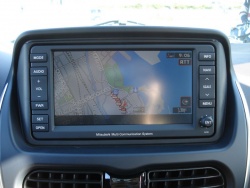 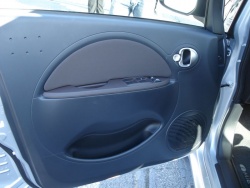 Mitsubishi i-Miev. Click image to enlarge |
A few weeks ago I had the chance to drive the all-new 2012 i-MiEV for several days and found it to be a capable, comfortable vehicle for urban commuters. It never left me close to stranded, I was never a slow-moving obstacle for other drivers and I could easily exceed any posted speed limit in Canada if I felt so inclined. I found my driving range from a full charge would vary based on my driving style. Drive it like a hooligan and it would only do 75 km; drive it as economically as possible and I was on pace for 120–130 km. Speaking with other journalists who had also reviewed the i-MiEV, 100–110 km seemed to be the average range achieved in normal day-to-day driving. For those keeping score at home, Mitsubishi states the maximum range achieved so far in Canada has been in excess of 140 km.
The one, and really only, sticking point I had with the i-MiEV was the interior quality and feature content on the base version I had for review. I found it a bit too spartan for a vehicle costing nearly $33,000, not necessarily reflecting the fact that it is a cutting-edge electric vehicle that looks like it was driven straight off a sci-fi movie set.
The upgraded Premium model should take care of most of these concerns. Mitsubishi happened to have an i-MiEV Premium on hand for this event and I spent some time crawling over the interior. The upgraded cloth seating material is richer to the touch and the premium features matching cloth door inserts. The infotainment unit is the same system as found in the Mitsubishi Lancer Evolution and although it is not paired to the Evolution’s pounding 750-watt sound system, it does add a modern, technologically advanced feel to the highly advanced i-MiEV. Other upgrades include a leather-wrapped steering wheel with audio control buttons, leather-wrapped shift knob, and alloy wheels.
Mitsubishi has done a great job with this first-generation technology and only time will tell if it catches on in Canada. For more information on the Electriphobia Institute you can visit Electriphobia.com.











